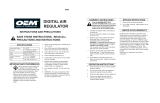
17308647
Parts List
Models 238893, 238894, 248090, and 255072
Ref.
No. Part No. Description Qty.
1 * ACTUATOR 1
2} 191584 HOUSING ADAPTER 1
3{n 191577 NUT, spring retainer 1
4 191578 HOUSING, base, for Models
238893 and 238894 1
197952 HOUSING, base,
for Model 248090 1
15J923 HOUSING, base,
for Model 255072 1
5{n 191579 VALVE HOUSING, sst 1
15J924 VALVE HOUSING,
for Model 255072 1
6} 191585 ROD, piston, for Models 238893,
238894, and 248090 1
15J920 ROD, piston, for Model 255072 1
7 * PLUNGER, spring 1
8 191583 PLATE, backing 1
9 113623 BASE HOUSING SCREW,
cap, socket-head; M10 x 1.5 x 70 4
11}z 114104 SCREW, machine 12
12 * DIAPHRAGM, regulator; TPE
cream colored 1
13 * DIAPHRAGM, regulator; PTFE 1
white 1
14{n 191914 SEAT, valve 1
15{n 113651 O-RING, packing; PTFE 1
16{ 112365 BALL, for Models 238893 and
238894 1
16n 15D092 BALL, for Models 248090 and
255072 1
17* 109213 O-RING, packing; PTFE 025 1
18{n 107079 O-RING, packing; PTFE 019 1
19 * O-RING, packing; PTFE 013 1
20{n 109450 O-RING, packing; PTFE 016 1
Ref.
No. Part No. Description Qty.
21{n 111858 SPRING, compression 1
22} 160062 SPRING, stabilizing 1
25 113654 GAUGE, pressure
for Models 238894 and 248090 1
28}z ––– COVER, diaphragm 1
29}z ––– HOUSING, diaphragm 1
30} 100326 SCREW, machine 1
31} 110341 REGULATOR, air 1
32} 100403 PLUG, pipe 1
33} 108190 GAUGE, pressure, air 1
34} 103656 NIPPLE, pipe, hex 1
35} 151519 NIPPLE, reducing; 1/4 x 1/8 npt 1
36} 192194 WASHER, support 1
15J921 WASHER, for Model 255072 1
37}z 180979 DIAPHRAGM; nylon, for Models
238893, 238894, and 248090 1
38 238896 PLUG, EZ Flush (includes Ref. 39)
for Model 238893 1
39 107509 O-RING, packing; PTFE 007
for Model 238893 1
40 15J922 RING, diaphragm,
for Model 255072 1
41 198241 PLUG, pressure for Models
248090 and 255072 2
42 111457 PACKING, o-ring; PTFE 012 for
Models 248090 and 255072 2
* Included in Fluid Diaphragm Repair Kit 238747
{ Included in Cartridge Repair Kit 238748
} Included in Air-Operated Conversion Kit 238749
n Included in Cartridge Repair Kit 248098
z Included in Diaphragm Housing Repair Kit
16P596.




















